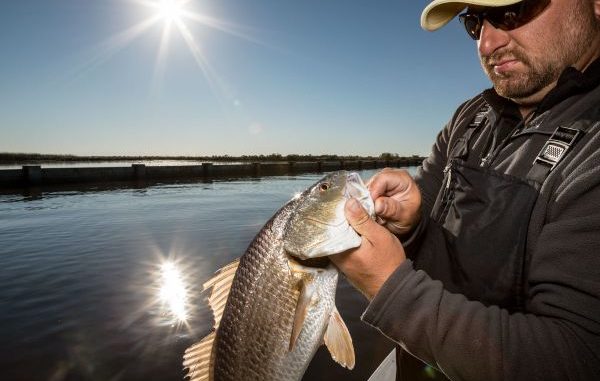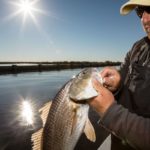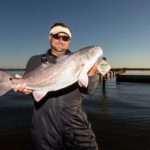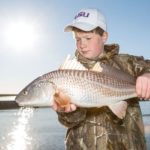
While politicians debate the merits of walls, this Lafitte guide knows one wall that is filled with redfish this month. And filling limits couldn’t be easier.
Opinions about walls are defined by the different sides.
On one side, a wall can be a hedge of protection that keeps us safe by keeping out the proverbial bad guys.
On the other side, a wall can be a divisive border designed to separate us from opportunities.
Whatever side of the wall you find yourself on, there’s no mistaking that walls have become a hot-button issue.
Donald Trump’s proposed wall between the United States and Mexico seems to be resonating with voters.
The Pope preached about the divisiveness of walls while on his trip to the United States while seemingly forgetting about his own wall around the Vatican.
Republican presidential candidates have even discussed the Berlin Wall and the Great Wall of China during recent political debates.
While a wall was the last thing on my mind last November as my son Matthew and I met Capt. Lane Zimmer (504-415-8006) at Seaway Marina in Lafitte, that was the first thing out of the guide’s mouth.
“We’re headed to the wall,” Zimmer said as he tossed a bag of dead shrimp into his boat.
I assumed “the wall” was some sort of angling analogy comparing Zimmer’s secret redfish hole to a figurative wall, but when we finally peaked out from our hoods at the end of a cold boat ride, we stood on Zimmer’s boat staring at a literal wall.
“I told you so,” he laughed as he started threading dead shrimp onto ¼-ounce jigheads.
The wall Zimmer had planned for us to fish was the one constructed on the east side of Bayou Rigoletts after Hurricane Katrina. It extends from the middle of the eastern shoreline all the way down to the south end of the bayou and into the Harvey Cut.
A recent cold front had lowered water levels around Lafitte, and the marsh behind the wall was draining out into Bayou Rigoletts.
As I was about to learn, my opinion of this particular wall was about to be shaped by what side of the wall we were on.
“What we need to try to do is cast right to the edge of the wall and pull out some slack so our shrimp fall to the bottom, scraping the concrete as they fall,” Zimmer instructed. “That’s going to put our bait right at that little corner down there where the wall meets the bottom.”
That’s when this particular redfish trip morphed into something resembling a catfish trip, since all we had to do was let our shrimp sit on bottom until a redfish with a keen sense of smell came within sniffing distance.
Patience wasn’t my strong suit when I was 12, and I apparently passed that lack on to my son, who couldn’t let his shrimp sit still for much more than a minute.
Zimmer gave him a good-natured scolding about the forth or fifth time he reeled it in too early.
“Boy, you’ve got to let that shrimp sit,” Zimmer chided. “You’re not going to throw it on their heads every cast you make.
“These redfish are patrolling up and down this wall, and it might take five or 10 minutes before a pile of them move through. If you don’t have your bait in the water, how do you expect you’re going to catch a fish?”
Flashbacks of my sitting on the bank of my grandfather’s catfish pond while listening to the same lecture filled my mind, so the best advice I could come up with was, “You better listen to the captain, son. He does this for a living.”
Like any kid who puts more stock in Dad’s advice whenever it comes from somebody else, Matthew let it sit long enough on his next cast and got the party started when a redfish just about jerked the rod out of his hand.
After boating the fish, Zimmer unhooked it and tossed it in the ice chest before taking a little time to explain what makes this particular structure so impressive.
“Right out in front of this wall, they dug a channel to move barges and dredges in and out,” he said. “That made a depression in front of the wall that created a trough that parallels the wall from one end to the other.
“Redfish use that trough to move through while they search for bait pulling out of any one of these cuts.”
The difference in depth might not seem like much to us, but when the rest of Bayou Rigoletts runs anywhere from 2 to 4 feet deep, a 5- to 8-foot deep trough is significant because it gives redfish somewhere to lie in wait beneath all the bait that washes out of the marsh.
After several more minutes of catching one redfish after another, the action slowed enough for Zimmer to contemplate a move to another spot on the wall.
Not being one to listen to directions, my son made one more cast after being told to pack it up for the move.
It just so happened that he made a cast to the left of the cut, near a point in the concrete wall that had up to this point gone unnoticed by any of us.
He was rewarded with yet another redfish.
“I thought you fished that corner,” Zimmer said me while unhooking the fish. “You’re in the back of the boat, so you were closest to it.”
According to Zimmer, all these little corners and points along the concrete wall are redfish magnets because they offer fish just a little bit something different than a long, straight wall.
“It doesn’t seem to matter if the angles are above or below the cut, either,” Zimmer said. “You’d think the ones below the cut would be best because that’s where the bait should wash to, but I’ve caught enough of them on angles above the cuts to know they can be just as good.
“Obviously, Matthew figured that one out, too.”
We stayed put and worked the angle until the little pod of redfish there moved on. After a few casts without a bite, Zimmer decided it was time to move down the wall.
The sheer length of the wall and number of angles, corners and cuts meant we would end up fishing a target-rich environment the remainder of the day.
Although all we used was dead shrimp on jigheads, Zimmer said reds along the wall will eat spinnerbaits and soft plastics, too.
“Anything that looks or smells like all the shrimp, crab and sometimes pogies that come out of the marsh behind the wall,” Zimmer explained. “For me, though, it’s hard to beat the dead shrimp because it’s just so easy.”
Our catch for the day was a box of redfish ranging from 16 to 27 inches. Zimmer noted back at Seaway Marina that just about every one of his trips this time of year produces a wide ranged of sizes — however, he hardly ever catches any bulls on the wall during November.
This structure, which was installed for erosion protection but has turned into a redfish magnet, is just so simple to fish.
“From Seaway, it’s only about a 6-mile run,” Zimmer said. “You can make it in just about any size boat you’ve got. The only thing that would make me think twice about heading out in a small boat would be a strong north wind.
“When the wind’s out of the north, it blows straight down the middle of Bayou Rigoletts; those waves get to whipping against the wall and bouncing right back out in the middle of the bayou. It can get kind of rough when it’s like that. Otherwise, it’s pretty smooth sailing.”
Walls might be a hot-button political topic during this election cycle, but they can also be hot-button fishing holes during November — especially the one on the eastern side of Bayou Rigoletts.
So if all the debate about building walls is getting too much for you to handle, head to one that has already been built.
Thankfully, you’ll find that this one has been built in the perfect spot to allow you and the redfish to hang out on the same side.
That might not be all that great for the redfish, but for you it’s a winning issue.



